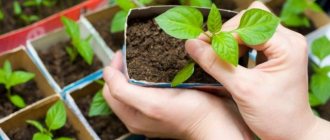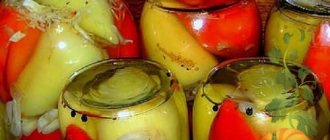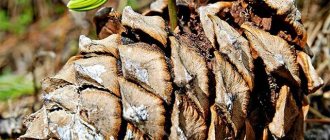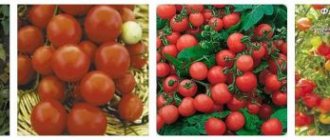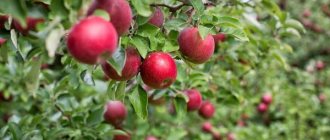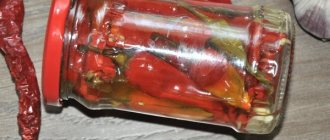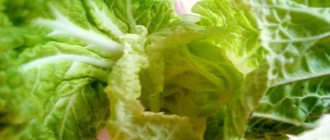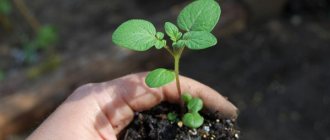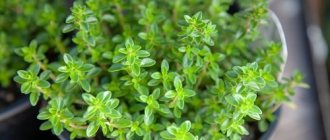Description and characteristics of pepper
Pepper Ogonyok can be planted in any environment. In the garden the bush reaches a height of approximately 0.4-0.5 m, in a pot - 0.3-0.4 m. The plant is pyramid-shaped. Refers to the mid-early period of ripening. The first harvest can be obtained 3.5-4 months after planting.
Flowers and pods can be observed on the plant at the same time. Productivity – 3.8 kg per 1 sq. m. The fruits are elongated, the shape is a narrow cone, the weight of one is 20 g, the walls are 1.5 mm thick. The pods are slightly twisted and become dark red when fully ripe.
Many companies sell completely different varieties under the name Ogonyok, whose fruits are yellow, small or stick out too much. They often mix mixtures of different spicy varieties that do not match the actual description of Ogonyok.
Experiment
The American proposed measuring the spiciness of hot peppers by the specific gravity of capsaicin in the vegetable.
The experiment was carried out as follows:
- The pepper was filled with an alcohol solution and infused for some time.
- The resulting extract was diluted with sweet water until the pungency disappeared. Five of Scoville's assistants tasted the pepper tincture, three of them had to confirm the disappearance of the heat.
- The volume of the sweet solution used was divided into parts in proportion to the volume of the extract, after which the result was entered into the table. 1 part is equal to 1 SHU - a unit of the Scoville scale.
Later, the method for assessing the hotness of pepper was refined and supplemented by the Russian scientist M. Tsvet using liquid chromatography, but the “hotness table” was given the name of the discoverer.
Advantages and disadvantages
Pepper Ogonyok has its pros and cons, which should be taken into account when growing the plant.
Advantages:
- the ability to grow not only in open ground, but also at home;
- small crown of the plant;
- strong immunity;
- bright aroma and pungent taste;
- decorative appearance;
- non-simultaneous ripening of fruits - the harvest can be harvested for a long time;
- there is no need to form the crown of the plant.
Disadvantages of the variety:
- confusion with seeds, different varieties are sold under the same name;
- average ripening period, after planting you need to wait more than 3 months to get a harvest, this characteristic is not suitable for residents of the northern regions;
- average yield.
Benefit
Hot substances (capsaicins), vitamins and minerals that make up the flame pepper have a beneficial effect on the body. When eating fruits, a person’s pulse quickens, sweating increases, and endorphins (chemical compounds that help relieve pain and cause emotional uplift) are produced. That is why it is recommended to introduce pepper into the diet in winter, in order not only to cope with the winter cold season, but also to make it easier to endure winter melancholy.
Planting and growing
Growing Ogonyok in open soil or on a windowsill is not difficult, but before planting the seeds you need to study all the rules in order to achieve a good result.
Seed preparation
Before planting, germinate the grains in a moist environment. Take damp gauze or cotton pads, place the grains in it and carefully wrap the gauze. Place in a container and cover so that the moisture does not evaporate longer.
For germination, place the seed in a dark and warm place (+25...+27 degrees Celsius) for two days. Open and check the seeds from time to time. As soon as they begin to hatch, transplant them into the soil. Do not allow the soil to dry out excessively, otherwise they will die.
You can plant seed without preliminary preparation, but it is better to germinate the seeds in advance.
Landing dates
Hot peppers take a long time to grow, and this should be taken into account. Pepper can be sown at any time, that is, all year round. For example, if you plant in the winter season (December-January), you can harvest the first fruits at the beginning of summer.
Be responsible when choosing a site for growing. The variety loves light, so choose a south or south-east window sill. During active sunlight, shade the plant. In the summer season, take indoor peppers out into the fresh air, but completely avoid drafts.
Hot peppers cannot withstand winds and drafts, so when ventilating the room, keep them away from balconies, vents and windows.
Soil preparation
You can sow grains in a purchased special substrate. But it is better to prepare the nutrient mixture with your own hands; it consists of: peat, river sand in a ratio of 2:1 and perlite.
Before planting seed, treat the soil against various fungal diseases; it is better to use a weak solution of potassium permanganate for this purpose. Or simply warm the soil in the oven (at 200 degrees for 20 minutes).
When growing a plant, pay special attention to the choice of container. Hot peppers form a not too large root system, which is located close to the surface of the earth. To grow this bush, choose containers with a volume of approximately 3 liters, and preferably 5 liters.
Peppers are always grown with a pick, so for the first time, take wide and shallow pots, and then transplant the seedling into an individual container. The presence of drainage is mandatory, this will help get rid of excess moisture. Before direct planting, lay a 25 mm layer of drainage on the bottom.
You can clearly see how Ogonyok peppers are soaked and germinated in the video below:
Planting seeds
Sow planting material to a depth of no more than 10 mm. At the same time, maintain a temperature of +25 degrees Celsius. After 10 days the plant will germinate.
Transplanting seedlings
The hatched sprouts are placed in a bright place with a temperature of at least +22 degrees Celsius. As soon as the pepper produces its first leaves, it is dived into different pots. After 2 months, Ogonyok can be planted in the lawn.
Features and rules of care
If you follow all the rules, then caring for the plant will not be difficult.
Stimulating flowering and fruiting with fertilizing
Flowering is ensured by a large amount of potassium in the soil. During this period, you need to use dry potassium or urea: 1 tbsp. l. for 5 liters of water. Nettle infusion has a beneficial effect on plant flowering.
In the warm season, you can add mineral fertilizers, for example, Dachnik or Ecohuminate, they have an excellent effect on the formation of ovaries. The products are used in dry form. After applying fertilizer, be sure to water the plant.
For information on caring for Ogonyok peppers at home, as well as about watering, fertilizing, and growing features, watch the video:
Organic matter will help improve the structure of the soil, increase fertility, and protect against harmful insects. To create the fertilizer, you need to collect 1 bucket of young foliage and fill it with cold water, leave for 10 days until the product begins to ferment and the foliage sinks to the bottom. Then strain the mixture and water the pepper with this infusion once every 10 days.
During fruiting, it is better not to fertilize the pepper at all, especially if the pods and leaves are in order. Further application of fertilizers is carried out after harvesting the fruits.
Lighting requirements
For pepper to develop, it needs long-term lighting, lasting approximately 14-16 hours. In summer or spring, Ogonyok can do without special phytolamps, but in winter and autumn it is impossible without additional lighting.
If the amount of light is insufficient, the plant begins to shed its leaves.
Temperature
In spring, the temperature should not fall below +20 degrees, and in winter +18 degrees Celsius. In the warm season, take pots with plants out into the fresh air.
Watering
Pepper Ogonyok needs moderate but regular watering. The soil should not dry out. Avoid overwatering the soil, as this can lead to rotting of the root system and death of the pepper.
If there is insufficient air humidity, spray the greenery. Use water for irrigation at room temperature and settled.
Crown formation
Pepper Ogonyok does not require crown formation. Unless, to give it a more decorative look, you can pinch the tops of the shoots. Thanks to this procedure, the bush will become much more magnificent. If you want the fruits to be larger and longer, remove a small part of the flowers.
Harvesting and collecting seeds
It is not difficult to determine the time of full ripening of the fruits of this plant, since pepper has a pronounced red color. The main signs of ripening of Ogonyok fruits:
- The pods acquire a characteristic bright red color.
- The pepper foliage turns yellow and the lower leaves dry out.
- Ripe fruits contain a large amount of bitter substances. Rub the pod on the back of your hand, if you feel a burning sensation, then the pepper is ripe and can be harvested.
The main sign of the full ripening of pepper is bitterness; the more pronounced it is, the longer it can last. If you harvested earlier than expected, you can use such pods for preservation.
Also, unripe fruits can be placed in a warm place where they ripen. Use only ripe pods to collect seeds.
Reproduction
This plant can be propagated in two main ways: using seeds and cuttings. Let's look at them in order.
Seeds
Cut the pepper and remove the seeds. Dry them in the sun and put them in paper. This seed can be used in the future to propagate your indoor hot pepper Ogonyok. Just remember that seeds do not last forever, and you need to plant them as early as possible.
By cuttings
In order for daughter plants to retain all the properties of their “parents,” it is better to propagate peppers by cuttings. Cut the branches from green young shoots without pods, approximately 70 mm long. Each cutting should grow a leaf, preferably 2 leaves. Before planting seedlings in the soil, soak the cuttings in a zircon solution (7 drops per 250 ml of water) for a day.
Application
Due to their chemical composition, peppercorns are used in cooking, medicine and cosmetology.
In cooking
Hot peppers are popular in many cuisines around the world: they are added to soups, vegetable stews and side dishes, and to meat and fish dishes. Medium-hot peppercorns are pickled, salted, fermented and used in marinades. Dried pepper is crushed and used as a seasoning. It goes well with basil, coriander, thyme and dried garlic. Hot peppers are an essential element of curry seasoning and Tobasco sauce.
In medicine
The following medicinal properties of hot pepper are known:
- normalizes blood circulation;
- improves liver function;
- helps cleanse blood vessels from bad cholesterol;
- helps with sore throat and severe cough;
- prevents the development of cancer cells;
- has a positive effect on potency;
- resists aging of the body;
- helps with insomnia;
- has anti-inflammatory and bactericidal effects.
Regular consumption of pepper in small quantities helps strengthen the immune system - this is associated with the vegetable’s ability to disinfect the intestinal tract, removing all toxins and harmful substances from the colon.
In pharmacology, capsaicin from hot peppers is used to make analgesics. Based on it, many painkillers, warming ointments, creams and tinctures have been created. Pepper plaster is used for muscle and joint pain, mustard plasters are used to treat cough, cellulite and stretch marks. Tinctures are taken orally to aid digestion, and pepper-based ointments are used for upper respiratory tract catarrh, radiculitis, arthritis, myositis and rheumatism.
When losing weight
Hot pepper light will become an assistant for those who are watching their figure and weight. The vegetable improves metabolic processes, stimulates blood circulation, which promotes the breakdown of fat cells. In addition, hot peppers help reduce the salt content in food, because you don’t need to add a lot of salt to spicy food, it already has a bright taste. And reducing salt in the diet also contributes to weight loss.
In cosmetology
Hot peppers are also used for cosmetic purposes. It is included in masks for aging skin and tinctures to improve hair growth and thickness.
Growing Ogonyok pepper in a pot at home
When growing at home, be sure to transplant the Ogonyok pepper into another pot with a new soil mixture once every 2 years. In the spring and until the end of summer, add various complex fertilizers to the soil (once every 2 weeks).
During flowering, pay more attention to the plant; many gardeners claim that it is at home that Ogonyok begins to shed its ovaries. If this happens, then the main reason for this phenomenon is insufficient pollination. It is easy to correct the situation - during flowering, carefully shake the bush (rock the pot from one side to the other).
Selection of soil mixture
For planting and good rooting of seedlings or seeds, it is recommended to purchase a high-quality soil mixture; when mixing the soil yourself, it is important to fertilize it with humus and peat, adding agroperlite and arranging drainage.
Excellent development of the plant is ensured by the choice of slightly acidic and loose soil; it is better to neutralize pests and diseases by watering the prepared soil with boiling water; this will help avoid future struggle with various parasites that attack the bush and its root system.
Diseases and pests
Ogonyok is a hardy plant. It contains special elements that fight diseases, so some ailments do not attack the bush at all.
If the leaves become a little paler or begin to fall off, then the reason lies not in disease, but in the lack of daylight. The main danger comes from two enemies: aphids and spider mites. They can attack peppers from other plants or fly onto your windowsill through a window.
How to get rid of spider mites and aphids:
- Take a couple of peppercorns and pass them through a meat grinder.
- Fill the mixture with water (1:10).
- Leave the mixture for a day.
- Strain through cheesecloth.
- Add crushed laundry soap (1 tsp per 1 liter of water).
- Spray peppers with this solution every 4 days.
To prevent the plant from being attacked by mites, simply maintain humidity in the room. The pest does not like a humid climate, so spraying will interfere with it.
Reviews of Ogonyok pepper
★★★★★
Alina, 26 years old, music teacher, Moscow. My family really loves spicy dishes, so I decided to grow Ogonyok pepper on my windowsill.
I bought the seeds from trusted sellers, but not all of them that I planted sprouted. I managed to grow several large bushes. The fruits are very spicy, ideal for us. The only thing that upset me was that one plant was destroyed by aphids. No matter what I did, I still couldn’t save him. ★★★★★
Vera, 65 years old, librarian, Omsk. I immediately bought seedlings and decided that I didn’t want to grow them myself from seeds.
The pepper grew slowly and received its first harvest only after 3 months. I like the fact that as soon as I collect the pods, the pepper already blooms and bears fruit again. I planted it all over the house, now we have sharp Ogonyok pods all year round. Hide
Add your review
Indoor pepper Ogonyok is a unique ornamental plant; it will not leave any housewife indifferent. The pods are used to prepare various dishes and are added to preserves. With proper planting and care of peppers, they will produce a healthy and tasty harvest all year round.
0
0
Copy link

